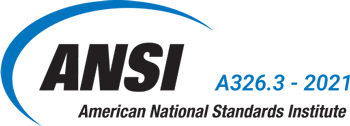FAQs
What is the ANSI A326.3 sanding process?
Recondition your sensor after each sample. (1) Sample = the average of (4) runs in all cardinal directions. To learn more please watch the Sanding Process video: Click here
What is the BOT-3000E System Verification process?
The BOT-3000E System Verification Process can be viewed in this video: Click here
How do I validate my sensor?
You can validate your sensor using the 2024 TCNA Reference tile strip. To view the process watch this video: Click here Note: if your sensor reads too high on validation -then its time to change your sandpaper strip. If your sensor reads too low, it could be due to SLS accumulation on the reference tile, therefore it is recommended to clean your reference tile with acetone or denatured alcohol.If you're using the formica reference surface, you can view the process steps in this video: Click here Note: it is recommended that you update your reference surface to the new 2024 TCNA Reference tile strip, available for purchase on our webstore.
What does a wet DCOF test value of less than 0.42 indicate?
If a walkway surface cannot meet the 0.42 threshold for wet testing, the test can be repeated in the dry mode. If the surface meets the 0.42 threshold in the dry mode that walkway must be kept dry to be considered slip resistant. If the walkway is exposed to involuntary wetness, a friction increasing treatment should be considered.
What should I do if the slip resistance value is below 0.42?
If enhanced cleaning does not raise the DCOF test results to 0.42 or higher, call Walkway Management Group for a consultation for professional remediation treatments.
Is it necessary to perform a BOT system verification each time you go to a new test site?
Yes. Regan Scientific Instruments strongly recommends device verification at each site to ensure proper tribometer results. A simple verification procedure is included in your BOT-3000E kit and takes only seconds to complete.
BOT-3000E Tribometer Operating Manual
You can find the BOT-3000E Tribometer operating manual here.
Which slip tests can the BOT-3000E perform?
The BOT-3000E is programmed to conduct either wet or dry A326.3 tests and create reports as defined in that standard. In the manual mode the BOT-3000E can be used for any other chosen method including SCOF and DCOF.
How often must the BOT be calibrated? Who does the calibration?
The NIST traceable calibration for the BOT-3000E is required once every 12 months and must be completed at the manufacturer's facility.
When do I change the travel distance on the BOT?
The BOT-3000E can test any distance between 4-36 inches. ANSI A326.3 calls for a test distance of 8 inches, well within the capability of the BOT-3000E.
Does the BOT-3000E perform Dry testing?
Yes the BOT-3000E can test the same surface either dry or wet.
Can I take the BOT-3000E on a commercial airline?
Yes the BOT-3000E can be taken on an airplane. Smaller Pelican Cases are permitted for carry-on. Larger Pelican Cases will NOT be permitted as carry-on but can be checked. To purchase a small pelican case for carry-on capabilities click here.

